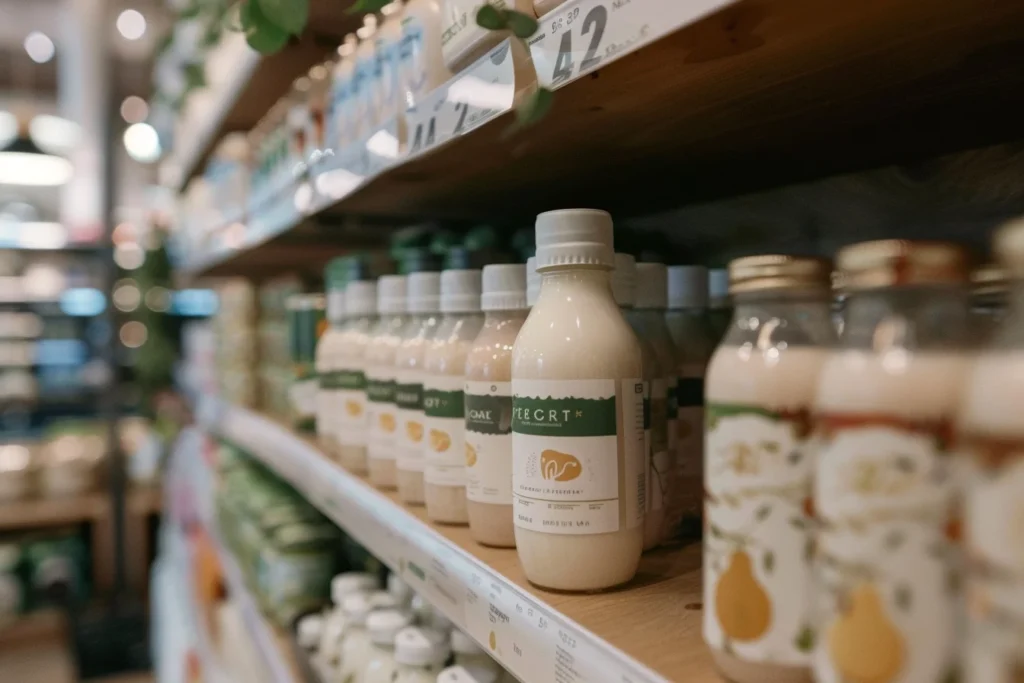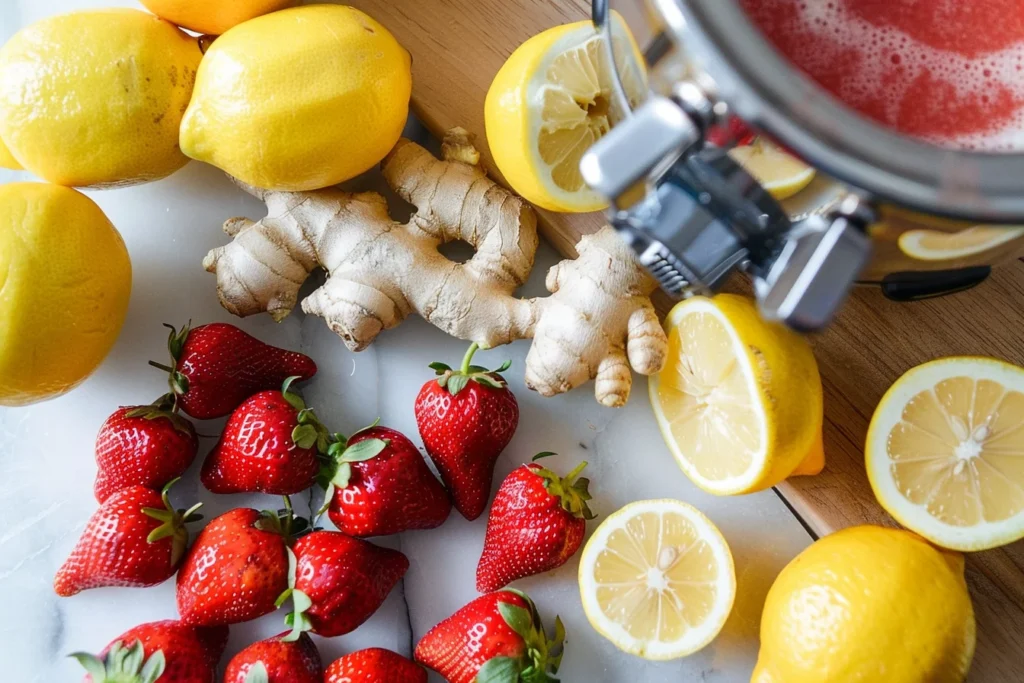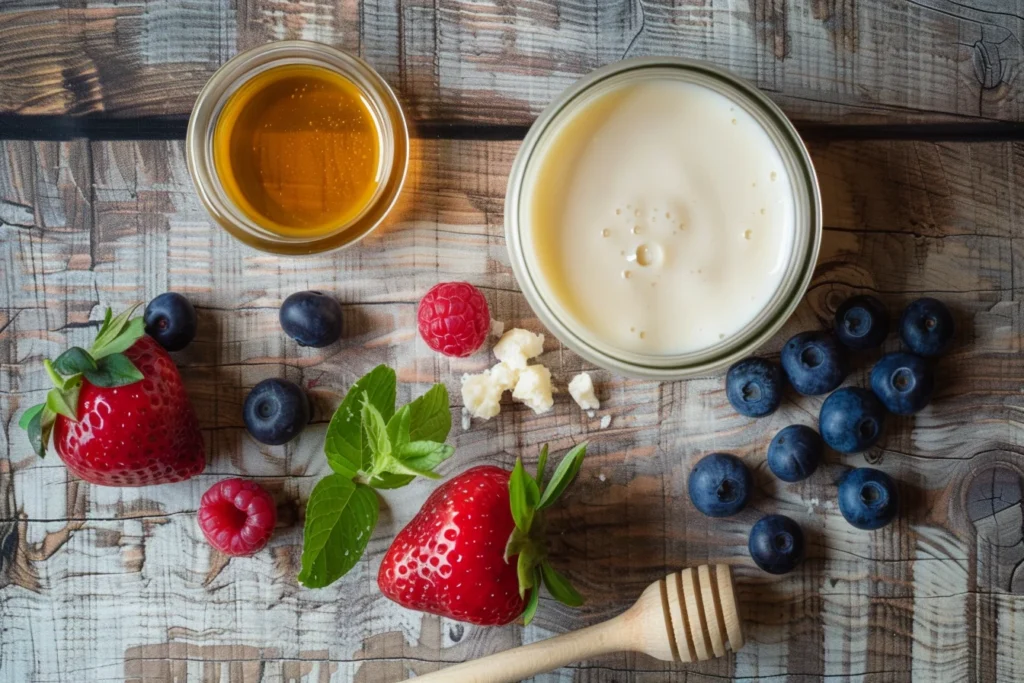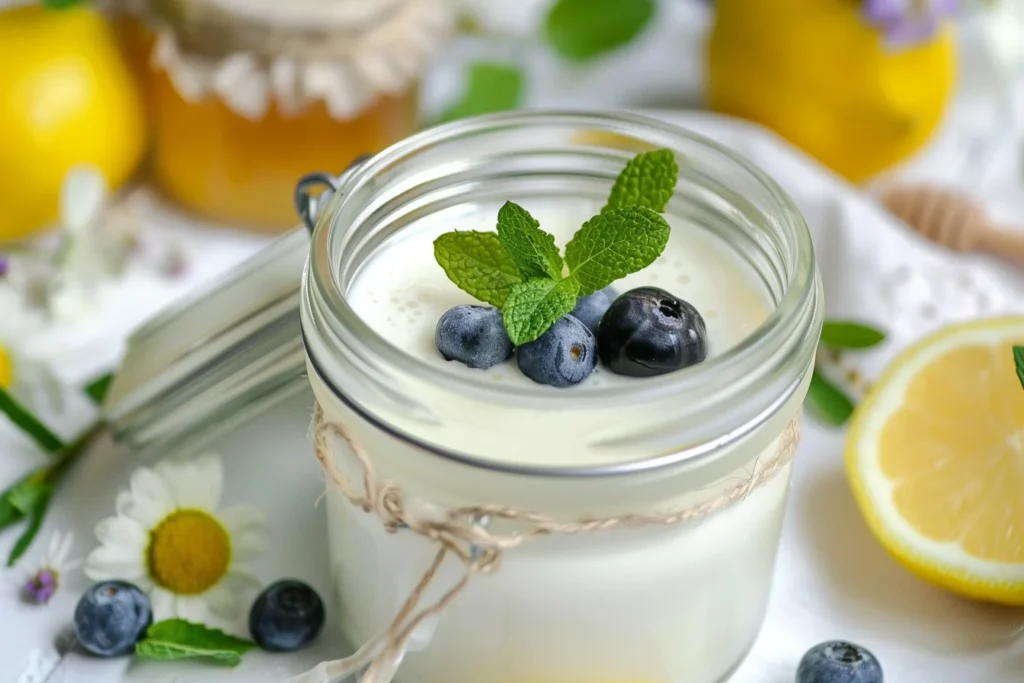
Are you tired of drinking plain kefir? 🤔 Sure, it’s packed with probiotics and great for your gut, but let’s be real—it can get a bit boring. The good news? Flavoring milk kefir is super easy and can completely transform your kefir game! Think fruity blends, creamy vanilla, or even a chocolatey twist. Sounds delicious, right?
In this guide, I’ll show you how to flavor milk kefir step-by-step, share some of the best combinations, and tackle common problems along the way. Whether you’re a kefir newbie or a seasoned fermenter, you’ll leave with plenty of ideas to keep your taste buds excited.
What Is Milk Kefir, and Why Should You Flavor It?
First things first—what exactly is milk kefir? Think of it as a tangy, creamy drink that’s like yogurt but thinner and way more probiotic-rich. It’s made by fermenting milk with kefir grains, which are little clusters of bacteria and yeast that work their magic to turn plain milk into a gut-friendly super drink.
So why should you bother flavoring it? Well, while plain kefir has a unique taste (a bit tangy, a bit sour), not everyone loves it straight up. Adding flavors not only makes it more enjoyable to drink but also opens up a whole world of delicious possibilities.
Here’s the best part:
“Flavoring your kefir is like turning a boring canvas into a masterpiece. You get to be the artist, and the possibilities are endless!”
Benefits of Flavoring Milk Kefir
- Improves Taste: Let’s face it, not everyone loves the tang of plain kefir. Adding flavors makes it more appealing.
- Increases Variety: Why settle for one flavor when you can have a new one every day?
- Boosts Nutrition: Adding fruits, herbs, and spices can enhance the health benefits of your kefir.
Understanding the Basics of Milk Kefir Fermentation
Before we dive into flavoring, let’s quickly go over how milk kefir fermentation works. The process is simple:
- First Fermentation: Kefir grains are added to milk and left to ferment at room temperature for 12-24 hours. The result? Plain kefir.
- Second Fermentation (Where the Magic Happens): This is where you add flavors. After straining out the grains, you can mix in fruits, herbs, spices, or sweeteners and let it ferment again for a few more hours.
Think of the first fermentation as the foundation and the second fermentation as the decorating stage.
Table of Contents
Different Ways to Flavor Milk Kefir: Natural and Creative Ideas
Now, let’s talk about the fun part—flavoring milk kefir! There are endless options, but I’ve broken them down into four categories to get you started: fruits, sweeteners, spices, and exotic flavors.
Using Fresh Fruits: Berries, Citrus, and More
Fresh fruits are one of the easiest and most popular ways to flavor kefir. Here are some fruits that work exceptionally well:
- Berries (strawberries, blueberries, raspberries): These add a burst of sweetness and color to your kefir.
- Citrus (lemon, lime, orange): Perfect for a refreshing, zesty flavor.
- Tropical Fruits (mango, pineapple, passion fruit): For a vacation-in-a-glass vibe.
Pro Tip:
If you’re using fresh fruits, mash them slightly before adding to the kefir to release their juices.
“Adding fruits to kefir is like adding a splash of sunshine to your morning routine!”
Sweeteners: Honey, Maple Syrup, and Natural Alternatives
If you prefer your kefir on the sweeter side, adding a touch of natural sweetener can do the trick. Here are some options:
- Honey: A classic choice that pairs well with almost any flavor.
- Maple Syrup: Adds a rich, earthy sweetness.
- Stevia or Monk Fruit: For a sugar-free option.
Remember to keep the sweeteners natural and avoid processed sugars to keep the health benefits intact.
Spices and Herbs: Cinnamon, Vanilla, and Mint
Spices and herbs can take your flavored kefir to the next level. Here are some to try:
- Cinnamon: Adds warmth and depth to your kefir.
- Vanilla Extract: A simple way to add a creamy, dessert-like flavor.
- Mint: Perfect for a refreshing, cooling effect.
Want to get creative? Combine cinnamon and vanilla for a chai-inspired kefir or add fresh mint leaves for a mojito twist.
Exotic Flavors: Coconut, Matcha, and Chocolate
Feeling adventurous? Try some exotic flavors:
- Coconut: Use coconut milk or shredded coconut for a tropical vibe.
- Matcha: Add a teaspoon of matcha powder for an antioxidant boost.
- Chocolate: Yes, you can make chocolate kefir! Simply mix in some cocoa powder and a touch of sweetener.
Classic Flavor Combinations to Try
Here are some tried-and-true combinations to get you started:
| Flavor | Ingredients |
|---|---|
| Strawberry Vanilla | Fresh strawberries, vanilla extract |
| Lemon Ginger | Lemon zest, grated ginger |
| Mango Coconut | Fresh mango, shredded coconut |
| Matcha Honey | Matcha powder, honey |
| Blueberry Lavender | Fresh blueberries, dried lavender flowers |
Step-by-Step Guide to Flavoring Milk Kefir
Let’s get into the nitty-gritty—how do you actually flavor milk kefir? The process is simple, but there are some key steps you’ll want to follow to ensure your flavored kefir turns out delicious and probiotic-packed.

There are two stages in kefir making:
- First Fermentation (Plain Kefir)
- Second Fermentation (Flavoring Stage)
The second fermentation is where you’ll add your flavors. This step not only enhances the taste but also reduces the sourness of the kefir, making it more enjoyable for those who find plain kefir too tangy.
First Fermentation vs. Second Fermentation: What’s the Difference?
The first fermentation involves adding kefir grains to milk and letting it ferment for 12-24 hours at room temperature. Once the kefir is done fermenting, you strain out the grains, and now you have plain kefir.
The second fermentation is where the fun begins! This is when you add fruits, spices, herbs, or sweeteners to your strained kefir and let it sit for another 12-24 hours. The extra fermentation time allows the added flavors to infuse into the kefir, creating a richer and more complex taste.
How to Add Flavors During the Second Fermentation
Here’s a step-by-step guide to flavor your milk kefir during the second fermentation:
Step 1: Prepare Your Plain Kefir
After the first fermentation, strain the kefir grains from your kefir and pour the strained kefir into a clean jar.
Step 2: Choose Your Flavors
Pick your favorite flavoring ingredients. You can use fresh fruits, dried fruits, herbs, spices, or even extracts like vanilla.
Some popular flavor options include:
- Fresh berries (strawberries, blueberries, raspberries)
- Citrus zest (lemon, lime, orange)
- Grated ginger
- Vanilla extract
- Honey or maple syrup
Step 3: Add the Flavoring to the Kefir
Add your chosen flavorings directly to the jar of kefir. You don’t need to add too much—just a few pieces of fruit or a teaspoon of spices will do.
“Think of flavoring kefir like making a smoothie—you want to balance the flavors so they complement, not overpower.”
Step 4: Seal and Let It Ferment
Cover the jar with a lid and let the kefir sit at room temperature for another 12-24 hours. This allows the flavors to infuse while continuing the fermentation process.
Step 5: Strain (Optional) and Chill
After the second fermentation, you can strain out any solid pieces (like fruit chunks) if you prefer a smoother kefir. Then, refrigerate your flavored kefir to stop the fermentation process and enjoy!
Tips for Balancing Flavor and Fermentation Time
Here are a few tips to help you get the perfect balance when flavoring kefir:
- Shorter fermentation time (12 hours) will give you a milder flavor.
- Longer fermentation time (24 hours) will make the kefir tangier and more potent.
- For stronger flavors, use more fruit or spices. For subtle flavors, use less.
- If you want sweeter kefir, add a natural sweetener like honey or maple syrup before serving.
“Fermenting kefir is a bit like brewing coffee or tea—everyone has their own preference for strength and flavor.”
Best Fruit and Flavor Combinations for Milk Kefir
If you’re not sure where to start, here are some delicious fruit and flavor combinations to try with your milk kefir:
| Flavor Combination | Ingredients | Taste Profile |
|---|---|---|
| Strawberry Vanilla | Fresh strawberries, vanilla extract | Sweet and creamy |
| Lemon Ginger | Lemon zest, grated ginger | Refreshing and zesty |
| Mango Coconut | Fresh mango, shredded coconut | Tropical and rich |
| Blueberry Lavender | Fresh blueberries, dried lavender flowers | Floral and fruity |
| Pineapple Mint | Fresh pineapple chunks, mint leaves | Fresh and tropical |
| Chocolate Banana | Cocoa powder, mashed banana | Sweet and chocolaty |
| Apple Cinnamon | Grated apple, ground cinnamon | Warm and comforting |

For a more adventurous take, look at the Blueberry Yogurt Muffins Recipe for a unique pairing idea.
How to Avoid Common Mistakes When Flavoring Milk Kefir
Even though flavoring milk kefir is simple, there are some common mistakes you’ll want to avoid. Let’s go over the most frequent issues and how to fix them.
Overpowering Flavors: How to Fix It
If your flavored kefir is too strong or overpowering, it might be because you added too much of a particular ingredient (like ginger or cinnamon).
Solution:
Start with small amounts of flavoring and increase gradually. You can always add more, but you can’t take it out once it’s overdone.
Weak or Bland Flavor: Tips to Enhance the Taste
On the other hand, if your kefir tastes too bland, it might be because you didn’t add enough flavor or didn’t ferment it long enough during the second fermentation.
Solution:
- Use riper fruits for more natural sweetness.
- Increase fermentation time to intensify the flavors.
- Add a splash of vanilla extract or a dash of cinnamon to boost flavor without overpowering.
Preventing Separation and Curdling
Sometimes, flavored kefir can separate or curdle, especially if you’re using acidic fruits like lemon or pineapple.
Solution:
- Add acidic fruits after the second fermentation is complete.
- Use non-acidic fruits like berries or bananas during fermentation.
- Stir the kefir before drinking to recombine any separated layers.
“Think of kefir like a science experiment—it’s all about finding the right balance of time, temperature, and ingredients.” ⚗️
Storing and Serving Flavored Milk Kefir
Now that you’ve flavored your kefir, it’s time to talk about how to store and serve it properly. Flavored kefir needs a little extra care to ensure it stays fresh, delicious, and full of probiotics.
Proper Storage Methods to Maintain Flavor
Flavored kefir can spoil if not stored correctly. Here’s how to keep it fresh:
- Use an Airtight Container:
Once your second fermentation is complete, transfer the flavored kefir to a clean, airtight jar or bottle. This prevents air exposure and keeps the probiotics active. - Refrigerate Immediately:
Flavored kefir should be stored in the refrigerator to stop the fermentation process. If left at room temperature too long, it may become too sour. - Label Your Kefir:
If you’ve made multiple flavors, label each jar with the flavor and date. Trust me, it’s easy to forget which is which! 😉
How Long Does Flavored Kefir Last?
Generally, flavored milk kefir lasts about 1-2 weeks in the refrigerator. However, the flavor may intensify over time as fermentation continues slowly in the fridge.
If you notice any of these signs, it’s time to toss it out:
- A strong, unpleasant smell (not the usual tangy kefir scent).
- Mold growing on the surface.
- A drastically changed texture, like curdling or separation that can’t be mixed back together.
Pro Tip:
To prolong the shelf life, strain out any fruits after the second fermentation. Fruits left in the kefir for too long can speed up spoilage.
Creative Serving Ideas for Flavored Kefir
Wondering how to serve your flavored kefir? Here are some fun ideas to try:
- As a Drink: Pour it into a glass and enjoy it as a refreshing beverage.
- In Smoothies: Blend your flavored kefir with extra fruits for a nutrient-packed smoothie.
- Over Cereal or Oatmeal: Use flavored kefir as a tangy alternative to milk or yogurt.
- As a Dessert Sauce: Drizzle it over pancakes, waffles, or even ice cream!
“Think of flavored kefir as a versatile base—you can drink it, eat it, or use it to jazz up your favorite dishes.” 🍽️
Health Benefits of Flavored Milk Kefir
We know that milk kefir is already a probiotic powerhouse, but what happens when you add flavors like fruits and herbs? You create a supercharged health drink that’s both delicious and nutritious.
Nutritional Boost from Fruits and Herbs
Adding fruits and herbs to kefir enhances its nutritional profile. For example:
- Berries are rich in antioxidants and vitamin C.
- Citrus fruits provide a boost of vitamin C and immune support.
- Ginger and turmeric have anti-inflammatory properties.
- Mint and basil offer digestive benefits and a refreshing taste.
By combining these ingredients with kefir’s probiotics, you’re creating a functional food that supports your gut and overall health.
Enhanced Probiotic Benefits
One of the best things about kefir is its high probiotic content. Probiotics help balance your gut bacteria, improve digestion, and boost immunity.
The second fermentation process (when you add flavors) actually increases the probiotic count, making flavored kefir even more beneficial.
Reduced Sugar Options for Healthier Flavors
If you’re concerned about sugar intake, you can still enjoy flavored kefir by choosing low-sugar or sugar-free options:
- Use stevia or monk fruit instead of honey or maple syrup.
- Add unsweetened cocoa powder for a chocolatey flavor without added sugar.
- Choose low-sugar fruits like berries instead of high-sugar fruits like bananas.
“Flavored kefir doesn’t have to be a sugar bomb—it can be as healthy as you make it!”
FAQs About Flavoring Milk Kefir
Let’s address some of the most common questions people have about flavoring milk kefir. If you’ve been wondering about something, chances are you’ll find the answer here.
How Long Should I Ferment Kefir After Adding Flavors?
The second fermentation typically takes 12-24 hours at room temperature. If you prefer a milder flavor, go for 12 hours. For a stronger, tangier flavor, ferment it for the full 24 hours.
What Are the Best Spices to Use in Milk Kefir?
Some popular spices include:
Cinnamon
Vanilla extract
Ginger
Cardamom
These spices add warmth and depth to your kefir, making it taste more like a dessert than a probiotic drink.
Can I Flavor Milk Kefir with Tea or Coffee?
Yes, but it’s a bit tricky. You can add brewed tea or coffee during the second fermentation for a unique twist. Just be sure to keep the flavors balanced, as too much tea or coffee can overpower the kefir.
How Do I Know If My Flavored Kefir Has Gone Bad?
Look out for these signs:
Mold on the surface
A foul smell that’s different from the usual tangy scent
A severely separated texture that can’t be mixed back together
Can I Use Frozen Fruits to Flavor Milk Kefir?
Yes! Frozen fruits work just as well as fresh ones. For more tips on how to preserve flavors, check out the Frozen Dessert Ideas Guide.
Can I Use Frozen Fruits to Flavor Milk Kefir?
Yes, you can! Frozen fruits work just as well as fresh ones. In fact, frozen fruits release more juice as they thaw, making your kefir even more flavorful.
When in doubt, it’s best to toss it out!

Conclusion: Get Creative with Flavoring Milk Kefir
And there you have it—a complete guide to flavoring milk kefir! The possibilities are endless, and the best part is, you can experiment with different flavors to find your favorites.
Flavoring milk kefir is a fun and creative way to enjoy your daily dose of probiotics. Whether you prefer fruity, sweet, or spicy flavors, there’s no wrong way to do it. For more creative ideas, explore this Crookie Recipe Guide to inspire your next culinary adventure.
Remember, flavoring kefir is like painting on a blank canvas—get creative, try new combinations, and enjoy the process. Whether you’re adding fruits, spices, or even coffee, there’s no wrong way to do it.
“So, grab your kefir grains, pick your favorite flavors, and let your creativity flow!”
